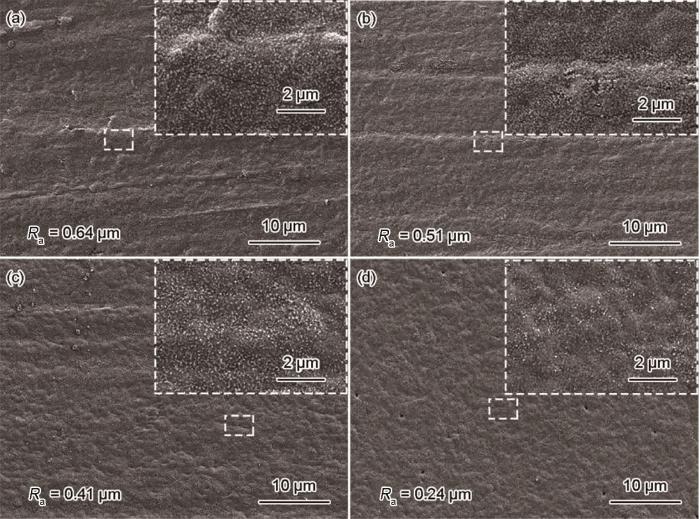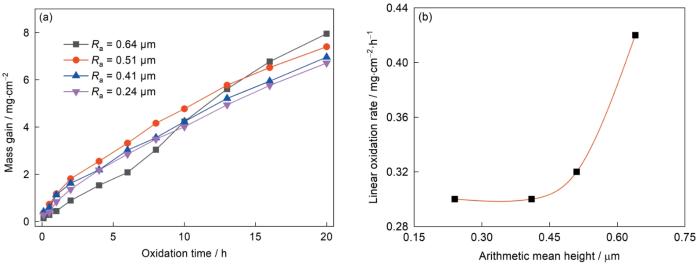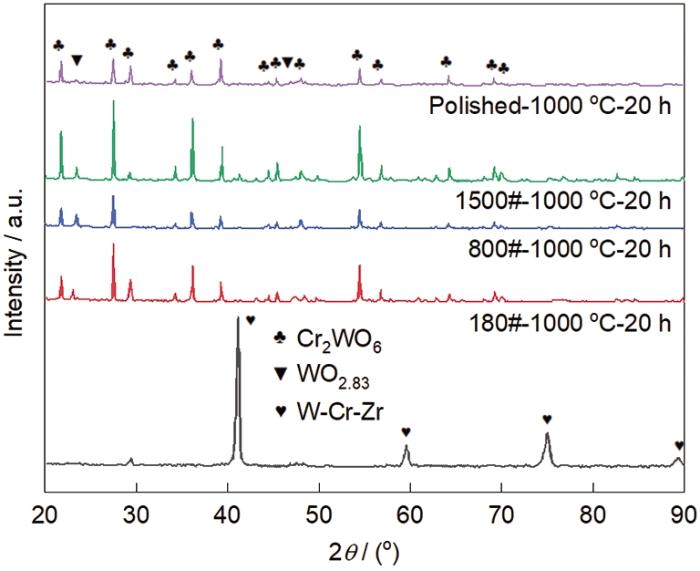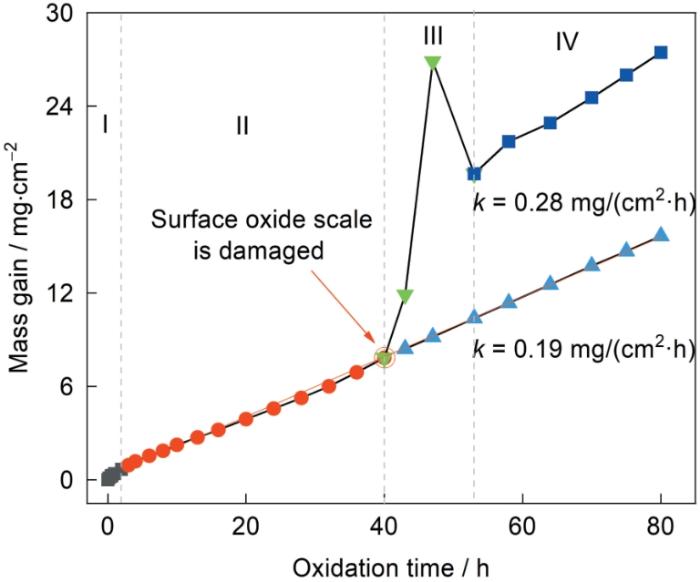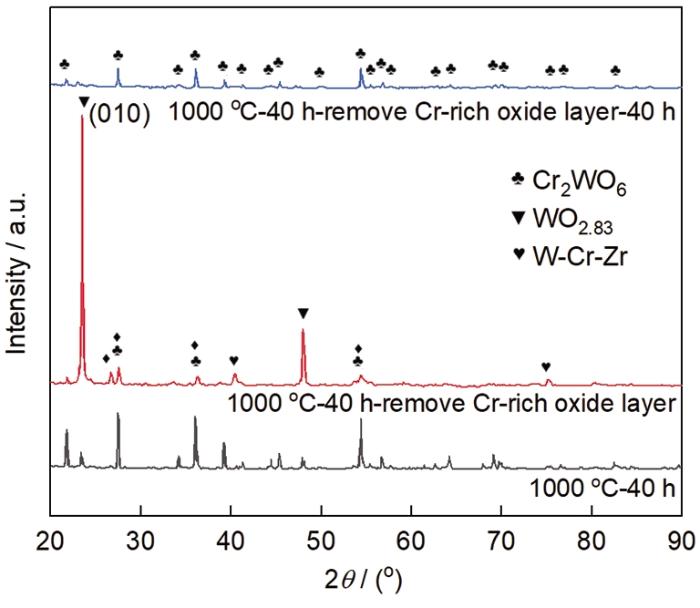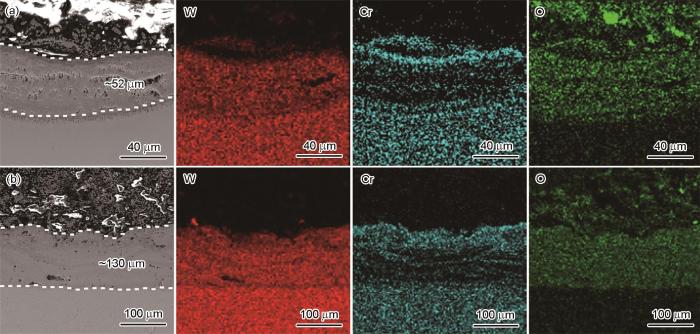钨(W)具有熔点高、蒸气压低、溅射率低、导热性能良好、热膨胀系数和氚滞留低等特点[1,2],是聚变反应堆中最有前途的面向等离子体第一壁材料[3,4]。核聚变装置运行时,可能发生冷却失水事故(LOCA,loss-of-coolant accident)[5]。发生LOCA后装置将停止运行,残余衰变热使真空室内的温度继续升高并可能达到1200 ℃和维持数周[6]。伴随真空室的破裂,易氧化的W[7]与空气中氧接触,发生的氧化、升华使第一壁W部件发生不可逆的损害。同时,W的氧化和升华可能产生核放射性泄露。许多研究分析了W在高温氧化气氛中的氧化行为[6,8,9]。Nagy等[3]绘制了W的氧化机理图,将其在600~1600 ℃的氧化行为分为抛物线氧化、线性氧化和升华。
SPTAs用作第一壁服役时直接暴露在高能粒子(氢、中子、氦等)的辐照下,其表面发生起泡、肿胀、形成fuzz结构、硬化和脆化等,即表面粗糙度发生变化。表面粗糙度的变化影响W氢/氦滞留行为,改变其表面的物理和化学性质,使部件的使用寿命缩短[13]。研究表明[14~16],表面粗糙度的变化会改变Fe基、Ni基高温合金表面氧化层的微观组织,从而影响其抗氧化性能。与W-Si基SPTAs相比[10],W-Cr基SPTAs具有更优异的抗氧化性能[8]。同时,W-Cr基SPTAs块体在高温氧化环境中其表面发生氧化的同时内部组织迅速调幅分解[17],也影响其抗氧化性能。材料的表面粗糙度和显微组织的变化都使其初始表面氧化层的微观结构发生变化,从而影响其抗氧化性能。鉴于此,本文研究W-Cr-Zr合金的表面粗糙度对其氧化行为的影响。
1 实验方法
实验用原料有钨(5 μm,99.9%,质量分数)、铬(Cr,< 200目,99.9%,质量分数)和氢化锆(ZrH2,< 200目,99.9%,质量分数),采用机械合金化(型号为QM-3SP04的球磨机,南京大学仪器厂)将原料按W、Cr、Zr组元的质量比为87.6∶11.4∶1.0混合制备W-Cr-Zr合金粉体,用间歇式球磨工艺,制备近乎完全固溶的合金粉体[18,19],然后结合场辅助烧结技术(型号Labox-6020 K,Field-assisted sintering technology,FAST)制备直径为30 mm厚度为5 mm的W-Cr-Zr合金块体。主要烧结工艺参数为:烧结温度约1350 ℃,升温速率约180 ℃/min,压力为40 MPa。
为了研究氧化层结构对W-Cr-Zr合金的氧化行为的影响,设计两类实验:使用不同表面粗糙度的材料进行氧化实验和改变氧化层结构进行后续氧化实验。
使用线切割切取直径为3.8 mm厚度为1.5 mm的样品,用SiC砂纸(180#、800#和1500#)和磨抛处理得到不同粗糙度的表面。用3D激光测量显微镜(型号VK-X250,Keyence公司)测定样品表面的粗糙度。
进行等温循环氧化实验评价W-Cr-Zr合金的氧化行为。进行氧化实验前,将实验用材料在酒精中超声清洗,然后在空气中干燥。为了避免装材料的氧化铝坩埚在氧化实验时影响质量增重,将其在1000 ℃保温足够长的时间。氧化时,将管式加热炉升温至(1000 ± 3) ℃[20],并通入流速为20 mL/min的Ar + 20%O2 (体积分数)混合气体,再将样品移入炉内。材料氧化一定时间后从炉中移出空冷,用高精密电子分析天平(型号MS105DU/A, Mettler Toledo公司,精度为0.01 mg)称量材料的质量,至少称量3次取其结果的平均值。然后再次将样品移入炉内,进行循环氧化实验以绘制钨合金材料氧化不同时间的质量增重曲线。
用扫描电子显微镜(SEM,型号Gemini 300, Sigma Zeiss公司)和X射线能谱(EDX)表征材料氧化前后的表面形貌和截面结构。将镶嵌的样品用金相砂纸(120#~800#)充分打磨和机械抛光后,测量材料样品的截面。用X射线衍射仪(XRD,型号X'Pert PRO MPD,Cu靶)表征材料氧化前的物相组成,以及氧化后表面氧化层的物相变化。采用3D激光测量显微镜表征氧化后样品表面的粗糙度。
2 结果和讨论
2.1 W-Cr-Zr合金的表面粗糙度对其氧化行为的影响
图1
图1
W-Cr-Zr合金氧化前的显微组织、不同表面处理后样品的表面形貌和相应的线粗糙度
Fig.1
Microstructure of W-Cr-Zr alloy before oxidation (a), the surface morphology of sample after different surface treatment (b~e) and the corresponding linear roughness (f)
图2给出了表面粗糙度不同的W-Cr-Zr合金在1000 ℃氧化2 min后的表面形貌。可以看出,W-Cr-Zr合金的表面粗糙度越低,表面氧化层越平整。高表面粗糙度(Ra = 0.64 μm)的样品其表面有明显的裂纹,如图2a所示。金属氧化时消耗的体积与生成的氧化物体积不同,意味着表面氧化层的生成产生了与其表面几何结构有关的生长应力[21]。对于表面粗糙度大的样品,表面凸起处更为明显,氧化严重时更易产生生长应力集中。大于氧化层强度的应力,使氧化层开裂,如图2a、b所示。表面粗糙度小的钨合金样品,在氧化初始阶段生成的氧化层发生“驰豫”释放部分生长应力,没有产生较大的应力集中,因此氧化层表面没有产生明显的裂纹,如图2c和d所示。在后续的氧化过程中W-Cr-Zr合金表面初始致密的氧化层阻碍氧离子向内扩散,使其具有良好的抗氧化性能。
图2
图2
表面粗糙度不同的W-Cr-Zr合金在1000 ℃氧化2 min后氧化层表面的形貌
Fig.2
Surface morphology of W-Cr-Zr alloy with different surface roughness after oxidation at 1000 oC for 2 min
(a) Ra = 0.64 μm, (b) Ra = 0.51 μm, (c) Ra = 0.41 μm, (d) Ra = 0.24 μm
图3a给出了表面粗糙度不同的W-Cr-Zr合金在1000 ℃的氧化行为曲线。可以看出,表面粗糙度不同的合金在氧化初期(约2 h)的氧化行为是抛物线,然后是线性的。氧化20 h后,样品质量的增加随着表面粗糙度的增大而增大。值得注意的是,在抛物线氧化阶段最大表面粗糙度(0.64 μm)的样品的质量增加最小。与SPTAs块体的原位氧化相比[26],图3a中的W-Cr-Zr合金其抗氧化性能更差。其主要原因是,循环氧化产生的热应力的多次作用使表面的脆性氧化皮开裂和剥落。由图2可见,表面粗糙度越大的样品,初始氧化层生成时就产生了裂纹。裂纹是氧的通道,在后续氧化阶段使合金的氧化加剧 [22]。在前期的抛物线氧化阶段,裂纹是亚表层氧化钨(WO2.83)挥发的通道,使其氧化增重最小。图3b给出了线性氧化阶段的氧化速率与表面粗糙度的关系。可以看出,随着表面粗糙度的提高线性氧化速率随之提高。值得注意的是,用800#砂纸表面处理后合金的线性氧化速率显著提高。这表明, SPTAs部件的表面粗糙度应该低于0.41 μm。
图3
图3
表面粗糙度不同的W-Cr-Zr合金在1000 ℃的氧化行为曲线和线性氧化速率与表面粗糙度的关系
Fig.3
Oxidation behavior curves of W-Cr-Zr alloy with different surfaces roughness when oxidation at 1000 oC (a) and the curve of linear oxidation rate as function of surface roughness (b)
表面粗糙度不同的样品其氧化前后表面的XRD谱,如图4所示。可以看出,表面粗糙度不同的W-Cr-Zr合金氧化20 h后其表面氧化层的物相构成均为Cr2WO6和WO2.83,只是含量不同。W-Cr基合金体系的主要氧化产物,是WO3和Cr2O3。在1000 ℃氧化时Cr2WO6是WO3-Cr2O3体系中唯一稳定的相[23],只有在高于1100 ℃的温度Cr2WO6才缓慢分解生成WO3升华[24]。单相WO3在1000 ℃时的饱和蒸汽压为12 × 10-3 Pa[25],升华速率为12.6 mg/(cm2·h)[26]。这表明,W-Cr-Zr合金在1000 ℃氧化时表面生成致密的Cr2WO6层能减缓氧向内扩散还能抑制WO3的升华,表现出良好的抗氧化性能[25]。
图4
图4
表面粗糙度不同的W-Cr-Zr合金在1000 ℃氧化20 h后的XRD谱
Fig.4
XRD patterns of W-Cr-Zr alloy with different surfaces roughness after oxidation at 1000 oC for 20 h
图5给出了表面粗糙度不同的W-Cr-Zr合金样品氧化20 h后表面氧化层的形貌。可以看出,随着合金表面粗糙度的降低,氧化层表面裂纹的数量逐渐减少。同时,在表面粗糙度为0.64和0.51 μm的合金样品表面依然能观察到砂纸的磨痕,如图5a和b所示。大量的裂纹有利于氧与基体接触,从而使其在氧化过程中的线性氧化速率较高。图5c和d分别给出了用1500#砂纸和精抛处理后的合金样品氧化的表面形貌,可见裂纹很少,能起到较好的抗氧化作用,因此线性氧化速率较低。结合图2、3和图5分析,W-Cr-Zr合金的氧化行为与其表面生成的氧化层的裂纹密切相关,而氧化层的裂纹与合金样品表面的粗糙度有关。由图2可见,表面粗糙度越大初始氧化层越易出现裂纹。在初生裂纹处氧化严重,应力集中使裂纹扩展和宽度加大,如图5a所示。表面粗糙度越小的样品,氧化时其氧化层表面上裂纹数量越少,从而使其抗氧化性能更好。金属材料高温氧化的本质是离子扩散[27],意味着高质量氧化表皮(裂纹少)能减缓氧向内扩散,从而使其质量增重较小。
图5
图5
表面粗糙度不同的W-Cr-Zr合金在1000 ℃氧化20 h后的表面形貌
Fig.5
Surface morphology of W-Cr-Zr alloy with different surface roughness after oxidation at 1000 oC for 20 h
(a) Ra = 0.64 μm, (b) Ra = 0.51 μm, (c) Ra = 0.41 μm, (d) Ra = 0.24 μm
图6a~d给出了表面粗糙度不同的W-Cr-Zr合金氧化20 h后的截面组织。可以看出,随着样品表面粗糙度的降低氧化层的厚度随之降低,统计结果如图6e所示。表面粗糙度(Ra)为0.64 μm的样品,氧化层最厚约为78 μm;表面粗糙度为0.24 μm的样品,氧化层最薄仅约为16 μm。同时,在氧化层内的空洞随着样品表面粗糙度的降低而减少。结合对图2的分析,粗糙表面氧化生成的初生裂纹强化了氧与基体的接触,使生成氧化层的质量较差,即氧化层表面出现大量的裂纹和空洞。图6f给出了表面粗糙度不同的样品氧化后氧化层表面的线粗糙度。可以看出,与氧化前表面线粗糙度的结果一致,即样品的初始表面粗糙度越大,氧化后氧化层表面的粗糙度越大。
图6
图6
表面粗糙度不同的W-Cr-Zr合金在1000 ℃氧化20 h后氧化层的截面、氧化层厚度与样品氧化前表面粗糙度的关系以及样品氧化后的表面粗糙度
Fig.6
Cross section of oxide scale of W-Cr-Zr alloy with different roughness surfaces after oxidation at 1000 oC for 20 h (a~d), the relationship between the thickness of oxide scale and surface roughness of samples before oxidation (e) and the surface roughness of oxide scales (f)
2.2 氧化层结构与长期抗氧化行为
金属材料高温氧化的本质是离子扩散[27],而在高温下离子扩散是不可避免。W-Cr-Zr合金应用在长期的高温氧化工况,意味着生成的保护性氧化层不可避免的因开裂和剥落而失效。因此,对氧化一定时间的氧化层处理后持续氧化,可评估其长期抗氧化行为。
为了进一步研究表面氧化层对氧化行为的影响,使W-Cr-Zr合金在1000 ℃、Ar + 20%O2(体积分数)气氛氧化40 h后,去除其表面Cr2WO6层继续氧化40 h。图7给出了相应的氧化增重曲线。可以看出,W-Cr-Zr样品在氧化初期表现出抛物线氧化行为,其钝化时间约为2 h (I阶段),而后表现为线性氧化行为(II阶段)。这意味着,合金氧化层已经开裂和氧化保护失效,其生长速率由金属与氧的反应速率控制,线性氧化速率(k)约为0.19 mg/(cm2·h)。去除失效的Cr2WO6层(图7)继续氧化时,合金的氧化增重急剧增加,可能是W基体迅速氧化所致。再氧化7 h后增重又急剧下降,表明原亚表层WO2.83升华所致。在1000 ℃,其升华速率达0.32 mg/(cm2·h)。第Ⅲ阶段的结果表明:表层Cr2WO6层破坏后,样品面临着W基体的氧化和WO2.83的升华。合金氧化超过53 h后,即到达Ⅳ阶段,再次表现出线性氧化行为。其线性氧化速率略高于氧化层未破坏时的线性氧化速率,约为0.28 mg/(cm2·h)。这意味着,W-Cr-Zr合金氧化层破坏后后续氧化时仍能回复到氧化保护状态,还能在一定程度上避免W氧化和WO2.83的升华。
图7
图7
W-Cr-Zr合金在1000 ℃氧化的氧化增重曲线(红线)和去除表面氧化物后的氧化增重曲线(蓝线)
Fig.7
Mass change curves of W-Cr-Zr alloy oxidation at 1000 oC (red line) and continuous oxidation after remove the surface oxide (blue line)
图8
图8
W-Cr-Zr合金氧化40 h后、去除最表层和再氧化40 h后的XRD谱
Fig.8
XRD patterns of W-Cr-Zr alloy after oxidation 40 h, remove top surface layer and continuous oxidation 40 h
图9给出了W-Cr-Zr合金氧化40 h、去除最表层、再氧化40 h后表面的形貌。可以看出,样品氧化40 h后在其表面已经产生大量的裂纹,如图9a、b所示。这表明,氧化层钝化保护失效表现出线性氧化行为。值得注意的是,氧化层表面存在两种形状的氧化物颗粒:类球形颗粒和不规则多边形颗粒,如图9b所示。结合EDX分析结果,球形颗粒中O∶Cr∶W∶Zr原子比为(66.26 ± 2.24)∶(21.66 ± 1.76)∶(11.68 ± 0.58)∶(0.50 ± 0.07),即为Cr2WO6;不规则多边形颗粒中O∶Zr∶Cr∶W的原子比为(67.02 ± 3.12)∶(23.30 ± 2.22)∶(6.14 ± 1.15)∶(3.56 ± 0.52),即为ZrO2/ZrW2O8。去除最表层氧化物后合金样品的表面较为干净,如图9c所示,EDX表征发现合金表面O∶Cr∶W∶Zr的原子比为(65.20 ± 3.05)∶(11.98 ± 5.35)∶(22.22 ± 2.46)∶(0.80 ± 0.34)。结合XRD分析(图8)发现,合金表面更多的是WO2.83。合金再氧化40 h后其表面形貌如图9e所示,可见较为疏松的表面。多孔的氧化层使氧更容易进入基体而使氧化加剧,因而表现出更高的线性氧化速率(图7)。EDX分析发现,氧化物中O∶Cr∶W∶Zr为(65.16 ± 1.22)∶(21.98 ± 1.17)∶(11.58 ± 0.42)∶(1.26 ± 0.89),表明其表面氧化物为Cr2WO6,与图8给出的结果吻合。
图9
图9
W-Cr-Zr合金氧化40 h后的表面形貌、去除最表层氧化物后的形貌以及再氧化40 h后的表面形貌
Fig.9
Surface morphology of W-Cr-Zr alloy after oxidation 40 h (a, b), after removing the top surface oxide layer (c, d) and then continuous oxidation 40 h (e, f)
图10给出了W-Cr-Zr合金样品氧化不同时间后的截面组织以及W、Cr和O的面扫描能谱。可以看出,合金氧化40 h后,如图10a所示,Cr主要分布在氧化层的最表面,亚表层为贫Cr区。结合图8和9分析,W-Cr-Zr合金氧化铬离子向外扩散生成Cr2WO6,而氧离子向内扩散生成WO2.83。Calvo等[28]和Sal等[17]研究W-Cr-Y合金和W-Cr-Y-Zr合金的氧化行为时,也发现最表层氧化物主要为Cr2WO6,亚表层氧化物主要为WO3。去除最表面Cr2WO6层继续氧化40 h,合金元素的分布没有发生明显的变化,如图10所示。这意味着,合金后续氧化时原亚表层WO2.83挥发或与Cr的氧化物生成了稳定的Cr2WO6,使其重新具有一定的抗氧化能力。同时,氧化层厚度的变化表明,再氧化40 h使氧化层的厚度增加了1.5倍。这个结果,与图9e中疏松的氧化层结构、图7中线性氧化速率的提高吻合。
图10
图10
W-Cr-Zr合金氧化40 h后的截面、再氧化40 h后的截面以及相应的W、Cr和O的面扫描能谱
Fig.10
Cross section of W-Cr-Zr alloy after oxidation 40 h (a), then oxidation 40 h, and the responding surface scanning energy spectra of W, Cr and O (b)
3 结论
(1) 随着W-Cr-Zr合金初始表面粗糙度的提高其氧化时生成氧化层产生的生长应力累积在表面凸起处,使表面氧化层产生更多的裂纹而加速基体氧化。
(2) W-Cr-Zr合金在1000 ℃的Ar + 20%O2(体积分数)气氛中氧化时,其氧化行为先遵循抛物线规律后遵循线性氧化规律。在线性氧化阶段,合金表面的粗糙度从0.24 μm增加到0.64 μm,相应的线性氧化速率从0.30 mg/(cm2·h)提高到0.42 mg/(cm2·h)。
(3) 随着W-Cr-Zr合金的长时间高温氧化其表面具有保护作用的Cr2WO6层开裂和剥落,在后续氧化时表面仍能生成具有一定抗氧化作用的Cr2WO6层,只是线性氧化速率略有提高。
参考文献
The routes and mechanism of plasma facing tungsten materials to improve ductility
[J].As a candidate for plasma facing material (PFM) in nuclear fusion situation, polycrystalline W with a characteristic of bad low temperature ductility shows brittle behaviour at room temperature and possesses a high ductile-to-brittle transition temperature, which limits its engineering application. In this paper, several common methods of grain refinement, addition of alloying elements, second-phase particles and tungsten fibre, and deformation processing for improving ductility of W are illustrated. To in-depth comprehend of how to improving W toughening, these toughening methods are discussed from intrinsic or extrinsic toughening mechanisms. Furthermore, the research status and development prospects for improving ductility of W materials have been presented.
面向等离子体W材料改善韧性的方法与机制
[J].
Research progress in irradiation damage behavior of tungsten and its alloys for nuclear fusion reactor
[J].Controlled thermonuclear fusion energy, regarded as the ultimate and ideal energy source, is considered as the principle way to effectively solve the future energy problem because of its cleaning and abundant raw materials. In the actual fusion reaction process, plasma facing materials (PFMs) will have to face the extremely harsh and severe environment. W and its alloys are the most promising PFMs candidate materials for the present reference design. However, due to its low-temperature brittleness, recrystallization brittleness, radiation-reduced brittleness and other disadvantages, they are still far from all the requirements of PFMs. In this paper, the principles of damage behavior under different irradiation particles were described in detail, and the research progress in related fields in recent years was also reviewed, in order to provide references for the research on the irradiation of W-based materials in the future.
核聚变堆用W及其合金辐照损伤行为研究进展
[J].受控热核聚变能作为一种清洁且原材料丰富的终极理想能源,被认为是未来能够有效解决能源问题的主要途径。而在实际聚变反应过程中,面向等离子体材料(plasma facing materials,PFMs)需要面临极其苛刻和恶劣的环境。W及其合金是目前最具有应用前途的PFMs的候选材料,但由于其低温脆性、再结晶脆性和辐照脆化等性能方面的不足,还不能达到PFMs的使用要求。本文对W及其合金在不同辐照粒子下的损伤行为的机制进行了详细阐述,并对相关领域近年来的研究进展进行了综合评述和展望,旨在为后期钨基材料辐照方面的研究提供参考。
An oxidation mechanism map for tungsten
[J].
Assessment of tungsten for use in the ITER plasma facing components
[J].
Development of yttrium-containing self-passivating tungsten alloys for future fusion power plants
[J].
The European power plant conceptual study
[J].
Interaction of tungsten nanopowders with air under different conditions
[J].
Microstructure and cyclic oxidation behavior of W-Cr alloys prepared by sintering of mechanically alloyed nanocrystalline powders
[J].
Self passivating W-based alloys as plasma facing material for nuclear fusion
[J].
Oxidation resistance behavior of smart W-Si bulk composites
[J].
New oxidation-resistant tungsten alloys for use in the nuclear fusion reactors
[J].
Evaluation of the high temperature oxidation of W-Cr-Zr self-passivating alloys
[J].W-Cr-Zr systems with different compositions were oxidized in a mixed gas (Ar + 20 vol.% O-2) atmosphere at 1000 degrees C. The power law which was used to describe the oxidation behaviour, indicates that W-11.2wt.%Cr-1.7wt.%Zr has an excellent oxidation behaviour. As analysed from the ten-hour exposure, W-Cr-Zr thin film oxidation shows a self-passivating stage followed by a linear oxidation stage. Furthermore, a study on the addition of zirconium indicates that zirconia particles act as diffusion barriers for the chromium cation diffusion and another function as the nucleation sites for the formation of the initial oxide scale.
Research status and trend of ultra-precision polishing on tungsten surface for fusion reactors
[J].Tungsten, as the most promising plasma facing material in the future fusion reactor, will withstand the irradiation impact of high energy particles under reactor condition. The surface quality of material will directly affect the hydrogen/helium retention behavior and the degree of radiation damage, thus affecting the safety and reliability of fusion reactor. At the present stage, the research on irradiation resistance modification of tungsten mainly focuses on the composition, structure and organization design of the material, few studies have been proceeded on the irradiation resistance modification of material surface. Focusing on the frontier scientific problems, the study intends to analyze the scientific problems in the field of nuclear materials from the perspective of mechanical processing, describes the necessity of ultra-precision polishing on the tungsten surface for nuclear fusion reactor based on the domestic and international research results and machining status of tungsten for nuclear fusion (PFM-W). Through comparing with different polishing methods, the viewpoint that magneto-rheological finishing and force-induced rheological polishing are more suitable for ultra-precision polishing of PFM-W surface. In addition, the future research trend of ultra-precision polishing of PFM-W surface is analyzed, with emphasis on the exploration of the polishing method and the influence of the surface quality of the polished material on the radiation resistance.
核聚变堆用钨表面超精密抛光的研究现状与趋势
[J].钨作为未来核聚变堆中最有前景的面向等离子体材料,在反应堆工况下将承受高能粒子的辐照冲击。表面质量的好坏会直接影响材料的氢/氦滞留行为和辐照损伤程度,进而影响聚变堆的安全性和可靠性。现阶段,针对钨的抗辐照改性研究主要着眼于材料的成分、结构和组织设计,关于机械加工对材料表面抗辐照改性的研究甚少。文章聚焦前沿科学问题,从机械加工角度分析核材料领域科学问题,结合国内外相关研究成果及核聚变堆用钨(PFM-W)的机械加工现状,阐述了PFM-W表面超精密抛光的必要性。通过对比不同抛光方法,提出了磁流变抛光和力流变抛光是较为适合PFM-W表面超精密加工的观点,并对未来PFM-W表面超精密抛光研究趋势进行了分析,重点在抛光方法的探索以及抛光后材料表面质量对抗辐照性能影响的研究。
Effect of surface roughness on oxidation resistance of stainless steel AISI 316Ti during exposure at high temperature
[J].
Effect of initial surface roughness on the cyclic oxidation behavior of an austenitic stainless steel
[J].
Effect of surface roughness on oxidation behavior of Ni-Cr-Al alloy at high temperatures
[J].
不同表面粗糙度镍铬铝合金的高温氧化行为
[J].
Microstructure, oxidation behaviour and thermal shock resistance of self-passivating W-Cr-Y-Zr alloys
[J].
Effect of pressure on densification and microstructure of W-Cr-Y-Zr alloy during SPS consolidated at 1000 oC
[J].
The influence of powder characteristics on densification behavior and microstructure evolution of W-Cr-Zr alloy consolidated by field-assisted sintering technology
[J].
Multifunctional high-temperature atmosphere tube furnace with multiple temperature zones
[P].
一种多温区多功能高温气氛管式炉
[P].
Effects of grain sizes on the oxidation behavior of Ni-based alloy 230 and N
[J].
Phase relations in the systems Cr2O3-WO3 and Fe2O3-WO3
[J].
The vapour pressure of tungsten trioxide
[J].
The reactive element effect on high-temperature oxidation of magnesium
[J].
Self-passivating tungsten alloys of the system W-Cr-Y for high temperature applications
[J].





